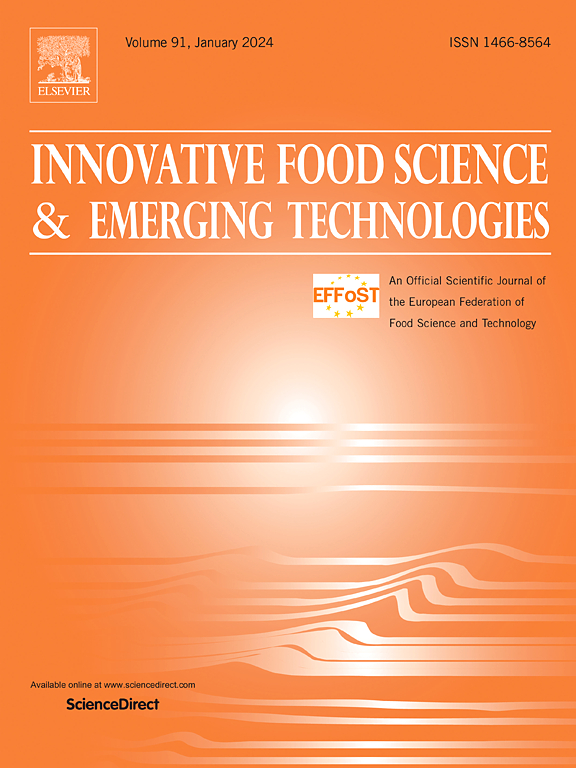Insights into the mechanisms of ultrasound treatment on plant tissue as revealed by TD-NMR, microstructural analysis, and electrical properties measurements
IF 6.3
1区 农林科学
Q1 FOOD SCIENCE & TECHNOLOGY
Innovative Food Science & Emerging Technologies
Pub Date : 2025-07-15
DOI:10.1016/j.ifset.2025.104116
引用次数: 0
Abstract
The aim of this study has been to investigate the impact of ultrasound (US) treatment on the structure, water distribution, and electrical properties of apple and carrot tissues. The influence of sonication power and duration was analysed. Slices of apple and carrot were subjected to ultrasound treatment at 21 kHz for 10, 20, 30, 45, and 60 min, using power levels of 180 and 300 W. Water distribution and its physical state were evaluated by means of the TD-NMR technique. Furthermore, the microstructure, electrical capacitance, and conductivity of the samples were studied.
In fresh (untreated) apple tissue, electrical conductivity increased significantly from 33.1 ± 3.1 to 53.8 μS/cm after 60 min of US treatment at 300 W. These findings were supported by NMR results and SEM imaging, which revealed increased porosity and the formation of microchannels, indicating disruption of cell membrane integrity in the apple. Free water from the vacuole was relocated to the extracellular spaces and cytoplasm, and to a lesser extent was retained by the cell wall.
In contrast, carrot tissue exhibited stable electrical conductivity (56.8 ± 5.0 and 52.8–64.3 μS/cm for fresh and US-treated samples, respectively), suggesting only subtle changes in cell wall organisation without membrane rupture. Moreover, based on both the electrical properties and NMR results, it may be concluded that water and ions were likely transmitted from the vacuole and retained by the cell wall in carrot tissue to a greater extent than in apple.
US-treated carrot samples were characterized by greater distances between cell residues and the formation of microscopic channels, with average cross-sectional cell areas increasing from 0.006 mm2 in untreated samples to 0.013 mm2 after 20 min at 180 W, and up to 0.015 mm2 after 30 min at 300 W.
通过TD-NMR,显微结构分析和电性能测量揭示超声波治疗植物组织的机制
本研究的目的是研究超声(US)处理对苹果和胡萝卜组织的结构、水分分布和电学特性的影响。分析了超声功率和持续时间的影响。对苹果和胡萝卜切片进行21 kHz超声处理,功率分别为180和300 W,处理时间分别为10、20、30、45和60分钟。利用TD-NMR技术对水的分布和物理状态进行了评价。进一步研究了样品的微观结构、电容量和电导率。在新鲜(未处理)苹果组织中,300 W的US处理60 min后,电导率从33.1±3.1显著增加到53.8 μS/cm。这些发现得到了核磁共振结果和扫描电镜成像的支持,显示孔隙度增加和微通道的形成,表明苹果细胞膜完整性被破坏。液泡中的游离水被重新安置到细胞外间隙和细胞质中,并在较小程度上被细胞壁保留。相比之下,胡萝卜组织表现出稳定的电导率(新鲜和us处理的样品分别为56.8±5.0和52.8-64.3 μS/cm),表明细胞壁组织只有细微的变化,没有膜破裂。此外,根据电学性质和核磁共振结果,可以得出结论,胡萝卜组织中的水和离子可能比苹果组织中的水和离子更大程度地从液泡传递并被细胞壁保留。经us处理的胡萝卜样品的特征是细胞残留物和微观通道形成之间的距离更大,平均横截细胞面积从未处理样品的0.006 mm2增加到180 W下20分钟后的0.013 mm2,在300 W下30分钟后增加到0.015 mm2。
本文章由计算机程序翻译,如有差异,请以英文原文为准。
求助全文
约1分钟内获得全文
求助全文
来源期刊
CiteScore
12.00
自引率
6.10%
发文量
259
审稿时长
25 days
期刊介绍:
Innovative Food Science and Emerging Technologies (IFSET) aims to provide the highest quality original contributions and few, mainly upon invitation, reviews on and highly innovative developments in food science and emerging food process technologies. The significance of the results either for the science community or for industrial R&D groups must be specified. Papers submitted must be of highest scientific quality and only those advancing current scientific knowledge and understanding or with technical relevance will be considered.

 求助内容:
求助内容: 应助结果提醒方式:
应助结果提醒方式:


